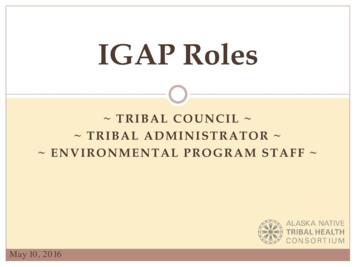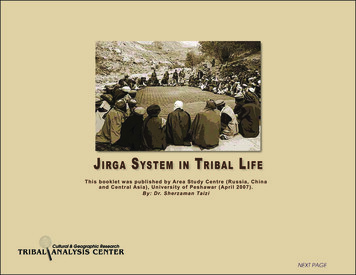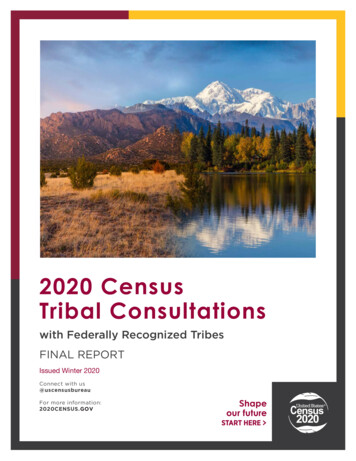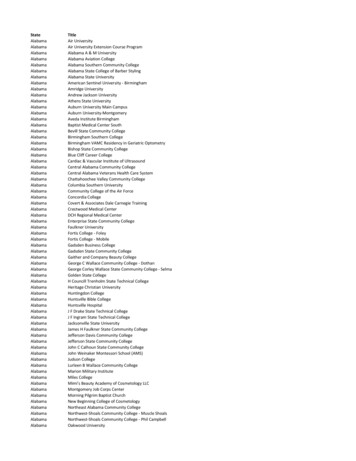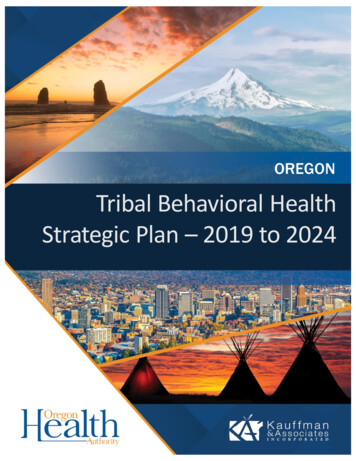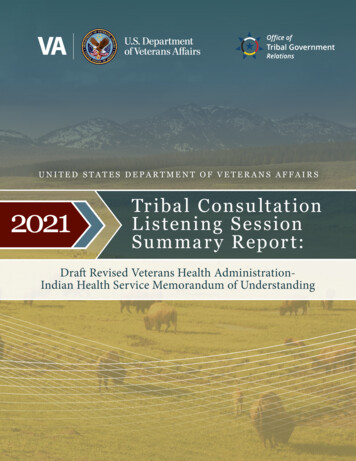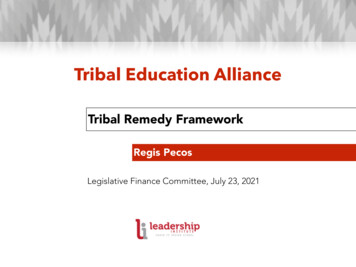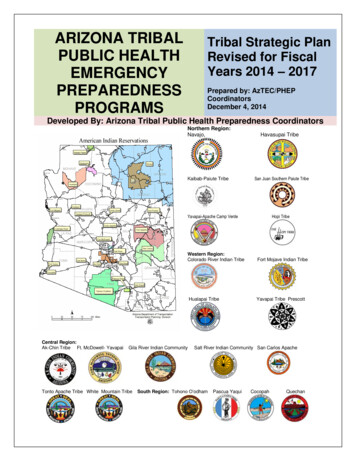
Transcription
ARIZONA TRIBALPUBLIC HEALTHEMERGENCYPREPAREDNESSPROGRAMSTribal Strategic PlanRevised for FiscalYears 2014 – 2017Prepared by: AzTEC/PHEPCoordinatorsDecember 4, 2014Developed By: Arizona Tribal Public Health Preparedness CoordinatorsNorthern Region:Navajo,Kaibab-Paiute TribeHavasupai TribeSan Juan Southern Paiute TribeYavapai-Apache Camp VerdeCentral Region:Ak-Chin Tribe Ft. McDowell- YavapaiWestern Region:Colorado River Indian TribeFort Mojave Indian TribeHualapai TribeYavapai Tribe PrescottGila River Indian CommunityTonto Apache Tribe White Mountain TribeHopi TribeSalt River Indian Community San Carlos ApacheSouth Region: Tohono O’odhamPascua YaquiCocopahQuechan
Strategic Plan Fiscal Years 2014- 2017Page 2
AzTEC and Tribal PHEP Coordinators Strategic Planning CommitteeCocopah TribeMike Fila. PHEP CoordinatorAzTEC Chairman of the Board14515 S. Veterans Dr.Somerton, AZ 85350mfila@cocopah.comC:928-750-6612O: 928-627-2025 X 12Colorado River Indian TribesMichael Gonzales, Tribal PHEP CoordinatorAzTEC Vice Chairman12302 Kennedy Dr.Parker, AZ 85344michael.gonzales@crit-dhs.org.C: 928-575-5148O: 928-669-6093Ft. Mojave Indian TribeChristine Medley, Tribal PHEP CoordinatorAzTEC Secretary500 Merriman Ave.Needles, CA 92363christinemedley@fortmojave.comO: 760-326-9650 C: 909-573-4899White Mountain Apache TribeShannon E. Tsosie, Tribal PHEP CoordinatorAzTEC MemberPO Box 1210Whiteriver, AZ 85941stsosie@wmat.usC: 928-594-1608O: 928-338-4955Hopi TribeVelleda Sidney, PHEP CoordinatorAzTEC Member123 Main StreetP.O. Box 123Kykotsmovi, AZ 86039vsidney@hopi.nsn.usC: 928-205-1251O: 928-734-3664Strategic Plan Fiscal Years 2014- 2017Page 3
Pascua Yaqui TribeFeliciano R. Cruz, PHEP CoordinatorAzTEC Member7474 S. Camino De OesteTucson, AZ 85757Feliciano R Cruz@pascuayaqui-nsn.govC: 520-260-7348O: 520-879-6124.Gila River Indian CommunityTori Begay, Tribal PHEP Coordinator / SNS CoordinatorAzTEC Sargent of Arms 433 W. Seed Farm RoadPO Box 7Sacaton, AZ 85247Toricellas.Begay@gric.nsn.usC: 520-610-0150O: 520-562-7197.Navajo NationDave Nez, Tribal PHEP CoordinatorAzTEC MemberP.O. Box 620St. Michaels, AZ 86511david.nez@nndoh.orgO: 928-871-7954O: 928-871-7959C: 928-206-2318.ADHS150 N. 18th AvenuePhoenix, AZ 85007Suite 150602-364-3289Non-Voting member.AzTEC Tribal Consultant and Meeting ModeratorPHirst 4 People, Inc. Luke Johnson, PresidentContracted Tribal Liaison Preparedness CoordinatorPO Box 5218 Mohave valley, AZ 86442760-238-3518 Luke Johnson@fortmojave.comStrategic Plan Fiscal Years 2014- 2017Page 4
Executive SummaryStrategic Plan 2010 Purpose. In 2010, the Arizona Tribal Collaborative Team successfullycompleted an approved Arizona Tribal Strategic Plan with the purpose to set goals for growthand direction for the Arizona Tribal Public Health Emergency Preparedness programs. TheTribal PHEP strategy is for a meaningful government-to-government consultation with ArizonaDepartment of Health Services (ADHS) in a designed program for Tribal PHEP Coordinators toaddress tribal public health issues through preparedness, capabilities achieved and response.The Strategic Plan contains a Mission Statement, Vision Statement, core values and guidingprinciples, and focus areas. Central to the Mission is the establishment of the Arizona TribalExecutive Committee (AzTEC). Purposed is the establishment of the Arizona Tribal ExecutiveCommittee with stated Bylaws2014 Purpose. The purpose of the Strategic Plan for budget periods from 2014 through 2017 isto keep the Arizona Tribal PHEP program abreast to public health threats through consultationbetween AzTEC and ADHS for allocations, budgets, work plans and deliverables.AzTEC Review and Update of Strategic Plan. AzTEC in accordance to their Bylaws in Octoberand December 2014 reviewed recommended changes to maintain this Strategic Plan for budgetperiods from 2014 through 2017. AzTEC, participating Tribal PHEP Coordinators and ADHS inteam effort has a Tribal public health emergency preparedness tool and guideline with which toserve the Arizona tribal public health communities.AzTEC 2010 Bylaw Summary Assessment. The AzTEC group completed an assessment onreaching the goals and objectives and where gaps remain to be address. See Page 6.Goal and ObjectivesGoal 1: To foster government-to-governmentrelationships to enhance tribal preparedness.Goal MetPartialTasks and ActionObjective Not Met: To achieve direct funding from CDC forindividual tribes. Objective Met: Greatly improvedgovernment-to-government relationship among agencies.Objective Not Met: Funding mechanisms for Navajo andITCA EPI Centers. All other objectives met.Goal 2: To create effective community awareness,preparedness, training and education programs forthe health of native people.Goal 3: To establish a process to review and haveinput into the requirements of the Public .Goal 4: To enhance the integrated all-hazards wholecommunity approach to public health emergencypreparedness.PartialGoal 5: Recognition of the Arizona Tribal ExecutiveCommittee (AzTEC) as the executive body forArizona Tribal Public Health EmergencyPreparedness Coordinators for serving as amediation team with ADHS for emergency conditionthat arise and for annual negotiated budgets, andprogram planning for the pending budget year.Goal 6: To identify alternative funding mechanismsfor tribes to participate in Public Health EmergencyPreparedness activities to include ADHS contractingprogram.YESObjective Met: AzTEC is fully formed and operational withapproved Bylaws, officers, and continually meet with ADHSto address Tribal PHEP preparedness and responseprograms.NOObjective Not Met: The plan was to address small tribesnot able to fully participate in the tribal PHEP program byseeking alternative funding mechanisms, not identifiableaction observed. Continue to work on.Strategic Plan Fiscal Years 2014- 2017YESPartialObjective Met. AzTEC and ADHS as PHEP planningpartners annually meet to address tribal allocations,budgets, work plans and deliverables. All emergency PHEPresponse programs addressed. I.E. H1N1 programObjectives Partially Met: Tribal EOC program are at 30%Objectives Partially Met: Tribal ICS program are at 30%.ABIL Functional Needs program an outstanding programplanned, implemented and completed.Page 5
TABLE OF CONTENTSTribal Consultation and Planning2014 Tribal Strategic Planning Committee Participants0203, 04Executive Summary05Table of Contents06Letter of ADHS Endorsement07Mission Statement, Vision Statement and Core Values08Review and Signature Sheet09AzTEC 2010 Strategic Plan Evaluation10, 11Goal 1: To foster government-to-government relationships to enhance tribalpreparedness.12, 13Goal 2: To create effective community awareness, preparedness, training andeducation programs for the health of native people.14, 15Goal 3: To establish a process to review and have input into the requirementsof the Public Health Emergency Preparedness Cooperative Agreement(s).16, 17Goal 4: To enhance the integrated all-hazards whole community approach topublic health emergency preparedness.18Goal 5: Recognition of the Arizona Tribal Executive Committee (AzTEC) as theexecutive body for Arizona Tribal Public Health Emergency PreparednessCoordinators for serving as a mediation team with ADHS for emergencycondition that arise and for annual negotiated budgets, and program planningfor the pending budget year.19Goal 6: To identify alternative funding mechanisms for tribes to participate inPublic Health Emergency Preparedness activities to include ADHS contractingprogram.20Appendix A: Executive Order 2006-1421Appendix B: Arizona Department of Health Services (ADHS)Tribal Consultation Policy22Appendix C: Presidential Memorandum on Tribal Consultation23Appendix D: Executive Order 13175Consultation and Coordination with Indian TribalGovernments24Appendix E: Executive Order 13527Establishing Federal Capability for the Timely Provision ofMedical Countermeasures Following a Biological AttackStrategic Plan Fiscal Years 2014- 2017Page 6
Office of the Director150 N. 18th Avenue Suite 500Phoenix, AZ 85007-3247(602) 542-1025(602) 542-0883 FAXInternet: www.azdhs.govStrategic Plan Fiscal Years 2014- 2017DOUGLAS A. DUCEY, GOVERNORWILL HUMBLE, DIRECTORPage 07
Mission StatementThe Arizona Tribal Public Health Emergency Preparedness Programs, in coordination with theCenters for Disease Control and Prevention and the Arizona Department of Health Services,serves as the focus for tribal health issues by preparing for and responding to our people’sneeds through tribal leadership and an integrated all-hazards whole community approach toimprove the health of tribal people on their lands.Vision StatementIt is through listening and learning we can understand what to recommend what is best for thepeople. As a liaison body we will listen to the drum beat and heartbeat of the people’s needs,as well as the latest medical technology to learn what is best for our people. It is our vision t olisten, learn, to understand, to respect, to acknowledge, and only then can we act wisely tocreate an effective emergency preparedness program for the health of our “People”.Core Values and Guiding PrinciplesThe Tribal Public Health Preparedness Programs are committed to serving the needs ofour people through a set core values and through the following guiding principles: Respect for our sovereignty, people and land by engaging in activities thatsupport and engage the following: Health Promotion and PreventionCommunity Preparedness, Response and MitigationInfectious Disease Surveillance and Disease ContainmentWorkforce Development through competency and capability-basededucation, training and exercisesCoalition partnerships with federal, state and local entitiesAll-Hazards, Whole Community approach to Public Health EmergencyPreparedness and Response (NIMS, NRF, HSEEP, etc.)Evaluation and Performance MeasuresTribal Consultation and Cooperation Executive Order 2006-14 (Appendix A) Arizona Department of Health Services, Tribal Consultation Policy(Appendix B) The Presidential Memorandum on Tribal Consultation (Appendix C) Executive Order 13175 Consultation and coordination with IndianTribal Governments (Appendix D)Regulatory and Compliance SystemStrategic Plan Fiscal Years 2014- 2017Page 8
AzTEC 2010 Strategic Plan EvaluationOctober 22, 2014AzTEC Annual Meeting, October 22, 2014The AzTEC Bylaws mandates the Arizona Tribal Executive Committee (AzTEC) to conduct theirBi-Annual AzTEC Meeting to review and evaluate the Tribal Strategic Plan effectiveness, makechanges, and update to the current Cooperative Agreement guidelines.The AzTEC/Tribal PHEP Coordinator developed and submitted the 2010 Tribal Strategic Planwhich was approved on January 15, 2010 with the purpose to set goals for growth and directionfor the Arizona Tribal Public Health Emergency Preparedness programs.The Tribal Strategic Plan was reviewed for effectiveness in January 2012. In accordance withthe AzTEC Bylaws, the Revised 2012 Tribal Strategic plan was reviewed for effectiveness inOctober 22, 2014 and December 04, 2014 during the Annual AzTEC meeting. The followingdocuments the review notes, changes and updates to the Goals and Objectives:AzTEC 2010 Strategic Plan EvaluationGoal and ObjectivesGoal 1: To foster government-togovernment relationships to enhance tribalpreparedness.Goal MetNOGoal 2: To create effective communityawareness, preparedness, training andeducation programs for the health of nativepeople.PartialGoal 3: To establish a process to reviewand have input into the requirements of thePublic Health Emergency PreparednessCooperative Agreement(s).YESStrategic Plan Fiscal Years 2014- 2017Evaluation for Effectiveness, Tasks and ActionObjective Not Met: To achieve direct funding from CDCfor individual tribes. The original objective proposed wasto work towards direct funding from the CDC as awardeesand following other agency programs for “Treatment asStates” (TAS). AzTEC task team met with the CDC onthis subject and found the Cooperative Agreementlanguage did not include TAS status and the Federal CFRwould have to be Congressionally change to accomplishthis objective. This objective is hereby recommended tobe removed by the AzTEC. Objective Met: Greatlyimproved are government-to-government relationshipgenerated among the State, county, tribal and healthcareentities. The Navajo Nation with ADHS has developed amulti-state PHEP initiative to serve the Navajo Nationsmulti-state status which is to be continuedObjective Not Met: Objective 2.4- Funding mechanismsfor Navajo and ITCA/EPI Centers not identified. All otherobjectives met. Supporting Evidence. MWPERLC wascontracted to develop the Arizona Tribal Needs planningdocument, (5) tribe voluntarily accepted and complete theprogram. Tribal ICS course among PHEP responders tomeet emergency operations and threats is partially met.Objective Met. AzTEC and ADHS as PHEP planningpartners annually meet to address tribal allocations,budgets, work plans and deliverables. All emergencyPHEP response programs addressed. i.e. H1N1response program.Page 10
Goal 4: To enhance the integrated allhazards whole community approach topublic health emergency preparedness.Goal 5: Recognition of the Arizona TribalExecutive Committee (AzTEC) as theexecutive body for Arizona Tribal PublicHealth Emergency PreparednessCoordinators for serving as a mediationteam with ADHS for emergency conditionthat arise and for annual negotiatedbudgets, and program planning for thepending budget year.Goal 6: To identify alternative fundingmechanisms for tribes to participate inPublic Health Emergency Preparednessactivities to include ADHS contractingprogram.PartialYESNOObjectives Partially Met: Tribal ICS program are at 30%.ABIL Functional Needs program an outstanding programplanned, implemented and completed.Objectives Partially Met: Tribal EOC programs are at30%Objective Met: AzTEC is fully formed and operationalwith approved Bylaws, officers, and continually meets withADHS to address Tribal PHEP preparedness andresponse programs. AzTEC in keeping with the Bylawsmet in the Fall of 2012 reviewed the Bylaws and TribalStrategic Plan with updates, revisions and election ofofficers.Objective Not Met: The plan was to address small tribesnot able to fully participate in the tribal PHEP program byseeking alternative funding mechanisms, no identifiableaction observed. Continue to work on.Tribal Strategic Plan Summary. In 2010, the Arizona Tribal Collaborative Team successfullycompleted an approved Arizona Tribal Strategic Plan with AzTEC formed and operational andas a partnership tool by which ADHS and the tribes are to to set goals for growth and directionfor the Arizona Tribal Public Health Emergency Preparedness programs. The Tribal StrategicPlan and formation of the AzTEC program is programmed to meet the intent of the CooperativeAgreements “Letter of Concurrence” wherein the tribes in the State of Arizona are afforded theopportunity to voluntarily participate in the Awardee PHEP program and the goals andobjectives are to enable tribes to develop meaningful PHEP preparedness programs to meet thethreat and challenges of health threat to the native people. The Tribal Strategic Plan with theAzTEC component is rated as highly successful by the combined review of the AzTEC andTribal PHEP Coordinators.Strategic Plan Fiscal Years 2014- 2017Page 11
GOALSGoal 1: To foster government-to-government relationships to enhance tribal preparedness.Strategy 1: To improve the relationship with the CDC and through the Arizona Department ofHealth Services as the awardee, to promote advocacy and support for tribal goals, objectives,and new initiatives.Aligned to FEMA Region ConceptNations (4)Ft. McDowell-Yavapai NationNavajo NationTohono O’odham NationYavapai-Apache Nation,Camp VerdeTribes (15)Cocopah Indian TribeColorado River Indian TribesFort Mojave Indian TribeHavasupai Indian TribeHopi TribeHualapai TribeKaibab-Paiute Indian TribePascua Yaqui Indian TribeQuechan Indian TribeSan Carlos Apache TribeSan Juan Southern PaiuteTonto Apache Payson TribeWhite Mountain Apache TribeYavapai- Prescott Indian TribeCommunities (3)Ak-Chin Indian CommunityGila River Indian CommunitySalt River Pima MaricopaIndian CommunityObjective 1.1: To continue the Strategic Plan process that facilitates true government-togovernment consultation with Arizona Department of Health Services and the Center forDisease Control and neighboring states for an integrated relationship and partnership in thePublic Health Emergency Preparedness program.Objective 1.2: To broaden an inter-tribal government-to-government integrated relationshipand partnership among tribes in promotion of the Public Health Emergency Preparednessprogram.Objective 1.3: To broaden the multi-jurisdictional government-to-government integratedrelationship and partnership among tribes, counties and public health entities in promotion of thePublic Health Emergency Preparedness program.Key Performance Indicators: Tribal PHEP programs offer PHEP Coordinator the opportunity to attend nationalCDC annual and scheduled public health emergency preparedness meetings,meetings sponsored by NACHO, and by tribal public health preparedness groupssuch as the National Tribal Advisory Committee Biannual Tribal Consultation Session. Schedule workshops, continued education, conference calls, establish planningcommittees for Public Health Emergency Preparedness activities among all participatinglocal jurisdictional partners. Evaluate the effectiveness of the PHEP program through semi-annual and annualreporting requirements of the CDC Cooperative Agreement.Purpose: The purpose in Strategy 1 Statement is “to improve the government-to-governmentmeaning tribal government to all levels of government including the CDC, ADHS, other tribaland county governments to build the relationship and partnership to promote advocacy andsupport for tribal goals, objectives, and new initiatives”.Strategic Plan Fiscal Years 2014- 2017Page 12
Supporting Evidence:The Arizona PHEP program is unique across the national CDC PHEP programs in that Arizonagovernment demands all state departments to have developed the department tribalconsultation policy in keeping with the Presidential Executive Orders, including ADHS. ADHShas implemented a strong Tribal PHEP program.Coalition Partnership. ADHS has implemented the multi-coalition partnership program wherethe state, counties, tribes and healthcare have scheduled meetings to plan partnership supportprograms to meet the challenges of diverse cultural population base of peoples and healthcaresystems that are threatened by disease outbreak and all public health emergency healththreats.Navajo Nation Multistate PHEP Planning. The Navajo Nation resides in three states andmultiple counties with inconsistent PHEP gaps. Through government-to-government dialoguethere is an ongoing collaborative effort to implement a Navajo Nation multi-statewide PHEPprogram.Strategic Plan Fiscal Years 2014- 2017Page 13
Goal 2: To create effective community awareness, preparedness, with education andtraining programs for the native people.Strategy 2: To share in the evaluation of existing program planning to identify gaps to improveagency capacity to plan, detect, respond, recover, and mitigate public health emergencies.Objective 2.1: To convey to ADHS tribal cultural impacts for the alignment of the tribal PHEPprogram to the current CDC Preparedness Capabilities.Objective 2.2: To build community awareness through educational and outreach programs fornative members understanding of the PHEP program.Objective 2.3: Through a coalition program among all PHEP jurisdictional partners, to developawareness programs for native member’s off-reservation.Objective 2.4: To develop operational capabilities to respond to public health threats bydeveloping tribal use of the Navajo and the Inter Tribal Council of Arizona (ITCA) EPICenter’s, which must be supported by additional funding sources and inter-tribalagreements (ITA’s).Objective 2.5: To improve our tribal community’s health by surveillance and mitigationprograms.Objective 2.6: To share in the training emergency preparedness personnel through communityoutreach and awareness programs and through universal independent study courses (ISC) toplanned emergency programs.Key Performance Indicators: ADHS evaluates tribal PHEP Coordinator response to capability workplans, noting localtribal impacts are conveyed. Plan community involvement in PHEP and emergency preparedness and responseactivities. Develop community preparedness plans that address preparedness, response, recovery,mitigation and community resiliency within tribal cultures. Community preparedness plansinclude Homeland/FEMA emergency preparedness planning including Essential SupportFunction – Public Health (ESF-8), ESF8-A Behavioral Health preparedness and THIRAs. Resource capacity plans are to include local community resources, jurisdictional partnerresources and state mutual aid programs and SNS. Percentage of local tribal emergency responders trained in the universal independentstudy courses (ISC) to planned emergency programs. Healthcare responders are to attainset aside IS courses programmed for health emergency preparedness planning.Supporting Evidence:Functional Needs Community Awareness Program. AzTEC and ADHS jointly in the 2013/2014Fiscal Year sponsored and contracted the Functional Needs Community Awareness Programwith Arizona Bridge to Independent Living (ABIL) on a statewide functional needs awarenessvisitation program, visited seventeen tribes providing function needs information,recommendations by local programs and examples of functional needs in the shelter program.The tribes reported high comments and timeliness of this community awareness program.Strategic Plan Fiscal Years 2014- 2017Page 14
Contracted Tribal Liaison Preparedness Coordinator. Purpose. The contracted tribal liaisonservices are in direct fulfillment of the Arizona Department of Health Services TribalConsultation Policy which provisionally provides for consistent and ongoing informationexchange and mutual understanding which leads to informed decision-making for the PublicHealth Emergency Preparedness (PHEP) programs between ADHS and all Arizona tribal publichealth programs. Through scheduled meetings conducted, onsite tribal lands visitation programto assist Tribal PHEP Coordinator to the PHEP tasks of budgets, work plans and deliverables.Strategic Plan Fiscal Years 2014- 2017Page 15
Goal 3: To establish a process to review and have input into the requirements ofthe Public Health Emergency Preparedness Cooperative Agreement(s)Strategy 3: To meet with appropriate officials to discuss and review the cooperative agreementrequirements, limitations, expectations and explanations of appropriations within a timeframethat allows for efficient planning.Objective 3.1: To continue the process that allows Arizona tribes an effective review ofallocations, budgets, work plan requirements, and deliverables, and active participation by theAzTEC group and Tribal PHEP Coordinators during the initial planning period of theCooperative Agreement.Objective 3.2: For the AzTEC group and Tribal PHEP Coordinators to have representation instate grantee awardee meetings to facilitate transparent communications regarding theCooperative Agreement requirements.Supporting Evidence: Letter of Concurrence. Described in the Cooperative Agreement, the awardee shouldprovide evidence that a majority, if not all, of American Indian/Alaska Native tribes withinthe jurisdiction approves or concurs with the approaches and priorities described in thisapplication. Documentation for tribal concurrence will be accomplished by:Attaching in PERFORMS (https://sdn.cdc.gov) a letter of concurrence from the IndianHealth Board representing the tribes within the awardees’ jurisdiction; orAttaching individual letters of concurrence from the American Indian/Alaska Native tribeswithin the jurisdiction, orAwardees who are unable to gain 100% concurrence, despite good-faith efforts to do so,should attach in PERFORMS a Word document describing the reason for lack ofconcurrence and steps the state has taken to address them.The AzTEC group provides a Letter of Concurrence that they have participated approveand concurs with the approach and priorities of the application. AzTEC/Tribal PHEP Coordinator Participation. Since the original implementation of the2010 Tribal Strategic Plan, AzTEC and Tribal PHEP Coordinator have participated eachyear in the effective review of allocations, budgets, work plan requirements, anddeliverables.Objective 3.3: To continue the vetting process that aligns deliverables and budgets with tribalpriorities.Supporting Evidence: Intergovernmental Agreements (IGAs). IGA components mirrors the CooperativeAgreement and is comprised of the following: Front Signature Page. Each tribal legal department and tribal administrators sign andagree to the terms of the IGA.Strategic Plan Fiscal Years 2014- 2017Page 16
The Uniform Terms and Conditions: This section is generic to all tribal IGAs withuniversal contractual language. Special Terms and Conditions: This allows each tribe to negotiate any special termsthat meets specific tribal priorities. It is here that tribes have a vetting process tonegotiate those special tribal priorities and budget issues. Scope of Work: Attached are the current budget year deliverables defining: a) tasks;b) administrative requirements, and c) financial reporting. Final page contains the award amount.Key Performance Indicators: Annual consultation with AzTEC group and ADHS on allocations, budgets, workplans and deliverables. Budget approved by all parties.Strategic Plan Fiscal Years 2014- 2017Page 17
Goal 4: To continue the integrated all-hazards whole community approach to publichealth emergency preparedness.Strategy 4: Adopted are the National Incident Management System (NIMS), the NationalResponse Framework (NFR) and all standardized policies, procedures and trainings to enhancethe all-hazards whole community approach to public health emergency preparedness withintribal communities.Objective 4.1: For Public Health Preparedness and Public Health Incident Command TribalStaff to meet a minimum level of NIMS compliance consisting of ICS 100, 200, 300, 400, 700,800 and 808.Objective 4.2: Continue national standardized guidance and compliance standards withinTribal Public Health Preparedness and Response Plans, plans, policies, procedures andexercises.Objective 4.3: To continue All-Hazards Public Health Preparedness Plans for each tribalcommunity.Objective 4.4: Continue increasing workforce development by attending trainings, conferencesand workshops to build and foster tribal knowledge and experience in an all-hazard, integratedwhole community approach to Public Health Preparedness and Response.Objective 4.5: Continue coordination and integration strategy with all local tribal responder andjurisdictional disciplines in the tribal region.Key Performance indicators: Percentage of local tribal emergency responders trained in the universal independentstudy courses (ISC) to planned emergency programs. Healthcare responders are to attainset aside IS courses programmed for health emergency preparedness planning. The tribal all-hazard whole community plan continues to have input on public healthpreparedness and response from all jurisdictional partners. Maintain all resource mutual aid programs to assure a supply of resource needs. Percentage of public health workforce participating in Training and Exercise Programs toaccess readiness and completeness of tribal preparedness and response capability. Percentage of tribe with an approved THIRA. Percentage of tribal responders in ICS complianceSupporting Evidence: Tribal ICS programs having ICS programs are ongoing Tribal EOC programs enumerated Tribal Training Officers Program. Tribal PHEP Coordinators have volunteered toparticipate in the FEMA Tribal Training Officers Program and receiving certification to teach andinstruct Independent Courses (IC) for the following IC programs: ICS-100; ICS-200; ICS-300;ICS-400; ICS- 402; ICS 700; ICS-800 and G-191 among Tribal PHEP Coordinators andprogram participants.Strategic Plan Fiscal Years 2014- 2017Page 18
Goal 5: Recognition of the Arizona Tribal Executive Committee (AzTEC) as the executivebody for Arizona Tribal Public Health Emergency Preparedness Coordinators for servingas a mediation team with ADHS for emergency condition that arise and for annualnegotiated budgets, and program planning for the pending budget year.Strategy 5: Continue to improve the Arizona Tribal Executive Committee (AzTEC) and thework AzTEC does on behalf of the Association of Tribal Public Health Emergency PreparednessCoordinators as tribal liaison to ADHS.Objective 5.1: AzTEC is to maintain the Bylaws that provide a business model for internaladministrative governance and interaction with Arizona Dept of Health Services PHEP program.Key Performance Indicators: Evidence of maintained Bylaws at the prescribe time periods for AzTEC/PHEPCoordinator review to update to current CDC/ADHS Cooperative Guidelines. Evidence of election of AzTEC Officers in leadership role Evidence of participation by PHEP Coordinators in decision making between AzTEC andADHS Evidence of AzTEC meetings that describe ADHS recognition of the Arizona TribalExecutive Committee (AzTEC) as the executive body for Arizona Tribal Public HealthEmergency Preparedness Coordinators for serving as a mediation team with ADHS foremergency condition that arise and for annual negotiated budgets, and program planningfor the pending budget year.Strategic Plan Fiscal Years 2014- 2017Page 19
Goal 6: To identify alternative funding mechanisms for tribes to par
The AzTEC/Tribal PHEP Coordinator developed and submitted the 2010 Tribal Strategic Plan which was approved on January 15, 2010 with the purpose to set goals for growth and direction for the Arizona Tribal Public Health Emergency Preparedness programs. The Tribal Strategic Plan was reviewed for effectiveness in January 2012. In accordance with
